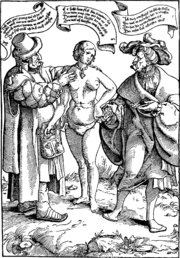From the Simple English Wikipedia, the free encyclopedia that anyone can change
 Size of this preview: 463 × 600 pixelsFull resolution
Size of this preview: 463 × 600 pixelsFull resolution (756 × 979 pixel, file size: 382 KB, MIME type: image/jpeg)
[edit] Summary
A 16th-century German satirical colored woodcut whose general theme is the uselessness of chastity belts in ensuring the faithfulness of beautiful young wives married to old ugly husbands. The young wife is dipping into the bag of money which her old husband is offering to give her (to encourage her to remain placidly in the chastity belt he has locked on her), but she intends to use it to buy her freedom to enjoy her young handsome lover.
For another closely-related 16th century woodcut (with different artwork, a better view of the lock, and the poem spelled according to a different German dialect, but basically the same idea), see Image:Alfons_luder_kunde.gif .
Here's an approximate rendering of the text in the image (based on a transcript of the text in the Image:Alfons_luder_kunde.gif version of the woodcut which is provided in Eric John Dingwall's 1931 book The Girdle of Chastity), arranged to bring out the poetic form:
-
- der alt man
- gelt und gütz gnung wil ich dir geben
- wiltü nach meinem wilen leben.
- greift mit er hand In mein taschen
- das schloss wil Ich dir erlasen.
-
- DES IUNG WEIB
- Eß hilft kain schlos vir frauwen list.
- kain trew mag sein da lieb nit ist.
- darumb Ein schlüsel der mir gfelt.
- den wil ich kauffen umb dein gelt.
-
- DER IUNG GSEL
- Ich drag Ein schlüßel zu solchen schlosen.
- wie wol Eß manchen hat verdrosen.
- der hat der narrn kappen vüll.
- der Rechte lieb ERkauffenn wül.
Here's an attempted rendering of this text into modern German:
-
- Der alte Mann
- Geld und Güter genug will ich dir geben
- willst du nach meinem Willen leben.
- Greif mit der Hand in meine Tasche,
- das Schloss will ich dir erlassen.
-
- Das junge Weib
- Es hilft kein Schloss vor der Frauen List
- keine Treue kann sein wo Liebe nicht ist.
- Darum einen Schlüssel, der mir gefällt,
- den will ich kaufen um[=für] dein Geld.
-
- Der junge Geselle
- Ich trage einen Schlüssel zu solchen Schlössern.
- obwohl es manchen verdrossen hat.
- Der hat der Narrenkappe viel,
- der rechte Liebe erkaufen will.
Dingwall translates what "DES IUNG WEIB" (the young wife) says as: "No lock is of avail against the cunning of women; there can be no fidelity where love is not present: for that reason will I buy with your money the key I lack".
This woodcut has been attributed to Peter Flötner and Hans Baldung, but Dingwall prefers to attribute it to H. Vogtherr (however, it is not entirely clear to me whether Dingwall is referring to this version, or to the alternative version Image:Alfons luder kunde.gif ).
[edit] Licensing
File history
Click on a date/time to view the file as it appeared at that time.
| Date/Time | Dimensions | User | Comment |
|---|
| current | 19:08, 28 April 2006 | 756×979 (382 KB) | AnonMoos | |
Links
The following page links to this file:



